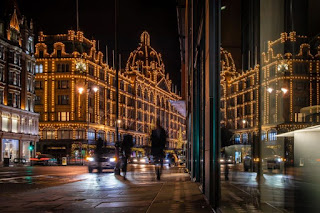"Go where we may, rest where we will,
Eternal London haunts us still." -- Thomas Moore===================================================================
(in the heart of London, England) Kensington and Chelsea, the royal borough in inner London, is part of the historic county of Middlesex. It occupies the north bank of the Thames River west of the City of Westminster. Forming part of London’s fashionable West End district, it is predominantly residential in character and includes a royal palace and the embassies of several countries. The borough includes areas such as North Kensington, Notting Hill, Kensington (featured here), part of Knightsbridge, Brompton, Earl’s Court, West Brompton, and Chelsea. (In medieval times the Manor of Chelsea was in the possession of Westminster Abbey.) With the dissolution of the monasteries in the 1530s, Henry VIII confiscated the manor, together with Sir Thomas More’s estate, and gave it to his last wife, Catherine Parr. Kensington Palace, which is still occupied by members of the royal family, is an originally Jacobean construction. Queen Victoria was born there in 1819. Notable buildings here include Earl’s Court Exhibition Hall, a massive reinforced-concrete structure covering 12 acres (5 hectares) of land, the Chelsea Old Church (which was associated with Sir Thomas More in the 1500s), the surviving wings of the 17th-century Holland House, and the Linley Sambourne House (a Victorian townhouse within which are displayed the 19th-century decor, and furniture of its namesake).
+ Splendidly well groomed, Kensington is one of London’s most attractive neighborhoods. Visitors find three fine museums here – the Victoria & Albert, the Natural History Museum and the Science Museum -- as well as excellent dining and shopping, graceful parklands and elegant streets of grand period architecture. This district's commercial heart is Kensington High Street, running on an east–west axis. The northeast is taken up by Kensington Gardens, containing the Albert Memorial, the Serpentine Gallery, and Speke's monument. South Kensington and Gloucester Road are home to Imperial College London, the Royal College of Music, the Royal Albert Hall, Natural History Museum, Victoria and Albert Museum, and Science Museum. (The area is also home to many international embassies and consulates -- and politicians.)
+ Just like double-decker buses, red phone boxes and palace guards with the funny hats, Harrods (dimly depicted here) is a true London icon. First opened in 1824, it has grown to become the largest department store in Europe, and one of Kensington’s biggest tourist attractions. Every year, hundreds of thousands of people are tempted to lose many of their "pounds" in this shopper’s paradise -- and, somewhat ironically for a store whose motto translates as "all things for all people, everywhere," still more come to wistfully gawk at the windows. For those who aren’t keen on dropping a princely sum for a new watch, there are other options, like teddy bears and chocolate bars.





No comments:
Post a Comment